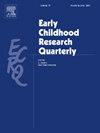儿童使用手机屏幕的类型和环境以及与幼儿行为的关联
IF 3.2
1区 教育学
Q1 EDUCATION & EDUCATIONAL RESEARCH
引用次数: 0
摘要
以往的研究主要集中在使用屏幕媒体(包括电视)的总体时间上,而对于幼儿期使用手机屏幕的类型和环境与儿童行为之间的关系却知之甚少。目前的研究旨在探讨使用手机屏幕的参与类型(观看节目与使用互动应用程序)和社交环境(单独使用与共同使用)所花费的时间比例与幼儿期内化和外化行为之间的关系,以及一年内使用模式的稳定性和变化。幼儿家长(n = 536;52% 为 1-3 岁幼儿,48% 为 3-6 岁学龄前儿童)完成了对儿童使用移动屏幕(即智能手机和平板电脑)、使用传统媒体(如电视)以及内化和外化行为的测量。幼儿使用手机屏幕的主要目的是观看节目,而使用互动教育应用程序则是第二常见的活动。在一年的时间里,儿童的参与类型和使用的社会环境相对稳定。行为与参与类型或使用的社会环境之间没有明显的横截面关联。然而,与假设相反的是,基线时观看节目的比例越低(即参与游戏或应用程序互动的比例越高),幼儿在一年随访中的外化行为就越多。稳定性研究结果表明,幼儿期可能是形成持续使用屏幕模式和习惯的关键时期。使用手机屏幕的类型和社会环境与行为之间的关联并不一致,这表明可能还需要考虑其他因素,如内容、相关互动和使用目的,以便更好地了解手机技术的使用如何与幼儿的社会心理发展产生关联。本文章由计算机程序翻译,如有差异,请以英文原文为准。
Types and contexts of child mobile screen use and associations with early childhood behavior
With past research largely focusing on overall time spent using screen media (including televisions), little is known about how the type and context of mobile screen use in early childhood is associated with children's behavior. The current study aimed to examine how the proportions of time spent on types of engagement (program viewing vs. interactive app use) and social contexts (solo vs. co-use) of mobile screen use were associated with internalizing and externalizing behavior in early childhood, examined along with stability and change in patterns of use over a one-year period. Parents of young children (n = 536; 52% toddlers aged 1 to <3 and 48% preschoolers aged 3 to <6) completed measures of child mobile screen use (i.e., smartphone and tablet), traditional media use (e.g., television), and internalizing and externalizing behavior. A majority of early childhood mobile screen use was spent on program viewing, while interactive educational app use was the second most common activity. Over a one-year period, children were relatively stable in their type of engagement, and social contexts of use. There were no significant cross-sectional associations of behavior with types of engagement or social contexts of use. Nevertheless, contrary to the hypothesis, a lower proportion of program viewing (i.e., higher proportion of interactive engagement on games or apps) at baseline was associated with greater externalizing behavior at one-year follow-up in toddlers. The stability findings suggest that early childhood may be a crucial time within which persistent screen use patterns and habits are formed. The inconsistent associations of types and social contexts of mobile screen use with behavior show that other factors such as content, associated interactions and purpose of use may need to be considered to better understand how use of mobile technology may be implicated in early childhood psychosocial development.
求助全文
通过发布文献求助,成功后即可免费获取论文全文。
去求助
来源期刊

Early Childhood Research Quarterly
Multiple-
CiteScore
7.00
自引率
8.10%
发文量
109
期刊介绍:
For over twenty years, Early Childhood Research Quarterly (ECRQ) has influenced the field of early childhood education and development through the publication of empirical research that meets the highest standards of scholarly and practical significance. ECRQ publishes predominantly empirical research (quantitative or qualitative methods) on issues of interest to early childhood development, theory, and educational practice (Birth through 8 years of age). The journal also occasionally publishes practitioner and/or policy perspectives, book reviews, and significant reviews of research. As an applied journal, we are interested in work that has social, policy, and educational relevance and implications and work that strengthens links between research and practice.
 求助内容:
求助内容: 应助结果提醒方式:
应助结果提醒方式:


